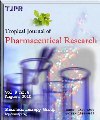
|
Tropical Journal of Pharmaceutical Research
Pharmacotherapy Group, Faculty of Pharmacy, University of Benin, Benin City, Nigeria
ISSN: 1596-5996
EISSN: 1596-5996
Vol. 1, No. 1, 2003, pp. 45-49
|
 Bioline Code: pr02007
Bioline Code: pr02007
Full paper language: English
Document type: Research Article
Document available free of charge
|
|
|
Tropical Journal of Pharmaceutical Research, Vol. 1, No. 1, 2003, pp. 45-49
| en |
Short Paper - Effect of acid treatment on the consolidation and plasto-elasticity of tapioca powder
Florence E Eichie and Roland S Okor
Abstract
Purpose:
The effects of treating the tapioca (the fibrous residue obtained after up to 90% of the proportion of starch has been removed from the peeled and rasped roots of cassava tubers powder with dilute solutions of hydrochloric acid) in order to find an approach for rendering an otherwise poorly compressible material to a directly compressible powder.
Method:
The parameters measured were the degree of consolidation of the powder after compression (i.e. the packing fraction of resulting tablets), the plasto-elasticity of the powders as reflected by the brittle fracture index (BFI) of the tablets made from the powders and the viscosities of mucilages derived from the powders. The influence of time of exposure and the concentration of acid used in the treatment were studied.
Results:
The degree of consolidation of the powder increased slightly with increase in duration of exposure to acid (24 - 72 h) but drastically with increase in the acid concentration from 0.1 to 0.4 mol. L-1. On the other hand, the plasto-elasticity of the powders as measured by the BFI values and the viscosities of mucilages derived from the powders decreased slightly with duration of exposure but drastically with increase in acid concentration. A change in acid concentration was therefore the more determinant factor with regards to the consolidation and plasto-elasticity properties of the powders. The decrease in the viscosities of the mucilages following acid treatment of the powders was indicative of a breakdown of polymeric structure in the powder
Conclusion:
Acid treatment of tapioca powder imparted plasticity in tapioca powder which became compressible.
Keywords
Plasto-elasticity, brittle fracture index, tapioca powder.
|
| |
© Copyright 2002- Pharmacotherapy Group, Faculty of Pharmacy, University of Benin, Benin City, Nigeria.
Alternative site location: http://www.tjpr.org
|
|
